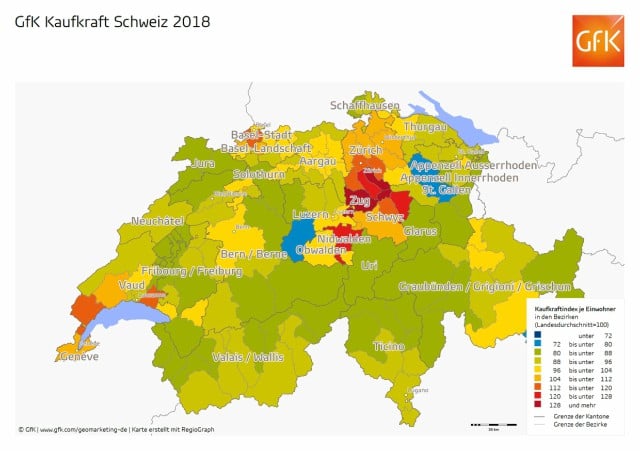Top of the heap: Switzerland’s 'richest' places by purchasing power

The central Swiss canton of Zug is at the top of the country’s purchasing power table with an average disposable net income of €60,000 (70,500 francs) per head a year, according to a new study by market research firm GfK.
That means the disposable net income of low-tax Zug is nearly one and a half times the Swiss average of €40,456.
It also puts the canton clearly ahead of fellow low-tax cantons Schwyz where the figure is €55,411 and Nidwalden (€51,449).
In Zurich, average disposable net income is €46,019, making it the fourth ‘wealthiest’ canton. Meanwhile, the total for fifth-placed canton Geneva is €43,737.
Read also: Here is how much tax Swiss people can expect to pay in a lifetime
There are large differences between the cantons at the top and the bottom of the GfK table though. In last-placed Jura, the figure is just €32,992. Uri and St Gallen round out the bottom three.

A GfK map showing the relative purchasing power of Swiss districts where the Swiss average is 100.
At a more local level, districts in the cantons of Schwyz and Zurich dominate the rankings. In the distract of Höfe (Schwyz), the average disposable net income is €87,853. The Zurich district of Meilen, on the so-called Gold Coast, comes in second place with €61,431.
In the French-speaking part of Switzerland, the wealthiest district is Nyon, where the disposable income is €61,431. That puts Nyon eighth on the overall list of Swiss districts.
The disposable income issue
But the GfK study does not make clear how much actual disposable income is actually available to Swiss people and families: while the market research firm looks at all types of income including government benefits, the figures it provides are before outgoings for costs including rent, insurance, electricity and clothing.
Read also: Here's why Swiss rents are so painfully high right now
A 2017 Swiss government study showed that the average disposable income in Swiss francs of households in 2015 was 6,957 francs a month or 83,484 francs a year. In that case, disposable income was calculated by deducting obligatory expenses including taxes, social insurance, health insurance and pensions from gross revenue, which includes salaries and bonuses, plus income from property, savings and investments.
But that same year, just 8.4 percent of Swiss people said they could not afford to go on a one-week holiday and 1.4 percent said they could not afford a full meal every second day, against 7.1 percent in Germany and 11.8 percent in Italy.
Another report released in 2017 showed that around 500,000 Swiss people, or around seven percent of the population were living below the poverty income threshold.
Comments
See Also
That means the disposable net income of low-tax Zug is nearly one and a half times the Swiss average of €40,456.
It also puts the canton clearly ahead of fellow low-tax cantons Schwyz where the figure is €55,411 and Nidwalden (€51,449).
In Zurich, average disposable net income is €46,019, making it the fourth ‘wealthiest’ canton. Meanwhile, the total for fifth-placed canton Geneva is €43,737.
Read also: Here is how much tax Swiss people can expect to pay in a lifetime
There are large differences between the cantons at the top and the bottom of the GfK table though. In last-placed Jura, the figure is just €32,992. Uri and St Gallen round out the bottom three.

A GfK map showing the relative purchasing power of Swiss districts where the Swiss average is 100.
At a more local level, districts in the cantons of Schwyz and Zurich dominate the rankings. In the distract of Höfe (Schwyz), the average disposable net income is €87,853. The Zurich district of Meilen, on the so-called Gold Coast, comes in second place with €61,431.
In the French-speaking part of Switzerland, the wealthiest district is Nyon, where the disposable income is €61,431. That puts Nyon eighth on the overall list of Swiss districts.
The disposable income issue
But the GfK study does not make clear how much actual disposable income is actually available to Swiss people and families: while the market research firm looks at all types of income including government benefits, the figures it provides are before outgoings for costs including rent, insurance, electricity and clothing.
Read also: Here's why Swiss rents are so painfully high right now
A 2017 Swiss government study showed that the average disposable income in Swiss francs of households in 2015 was 6,957 francs a month or 83,484 francs a year. In that case, disposable income was calculated by deducting obligatory expenses including taxes, social insurance, health insurance and pensions from gross revenue, which includes salaries and bonuses, plus income from property, savings and investments.
But that same year, just 8.4 percent of Swiss people said they could not afford to go on a one-week holiday and 1.4 percent said they could not afford a full meal every second day, against 7.1 percent in Germany and 11.8 percent in Italy.
Another report released in 2017 showed that around 500,000 Swiss people, or around seven percent of the population were living below the poverty income threshold.
Join the conversation in our comments section below. Share your own views and experience and if you have a question or suggestion for our journalists then email us at [email protected].
Please keep comments civil, constructive and on topic – and make sure to read our terms of use before getting involved.
Please log in here to leave a comment.